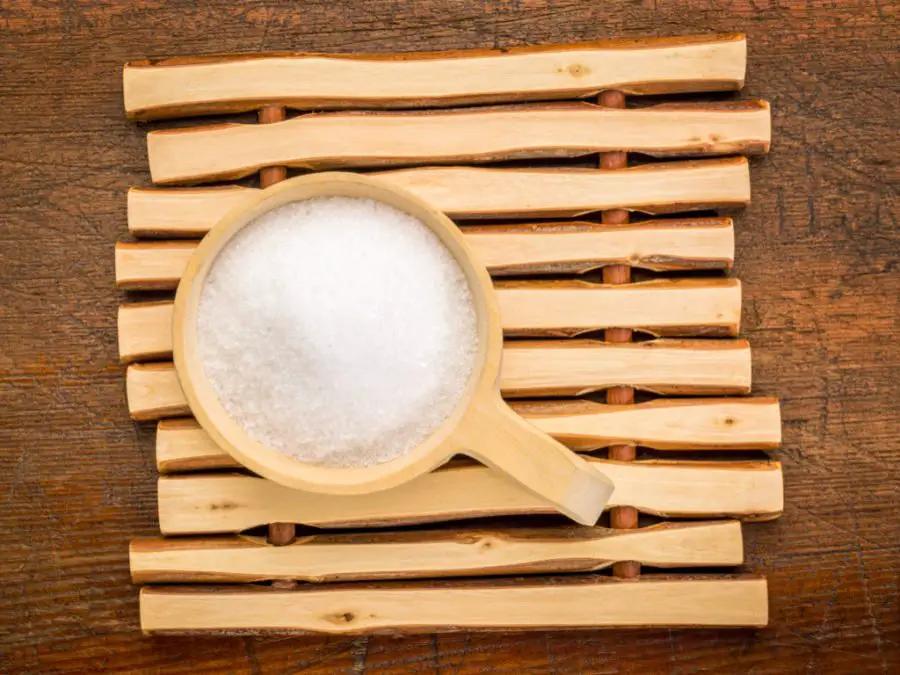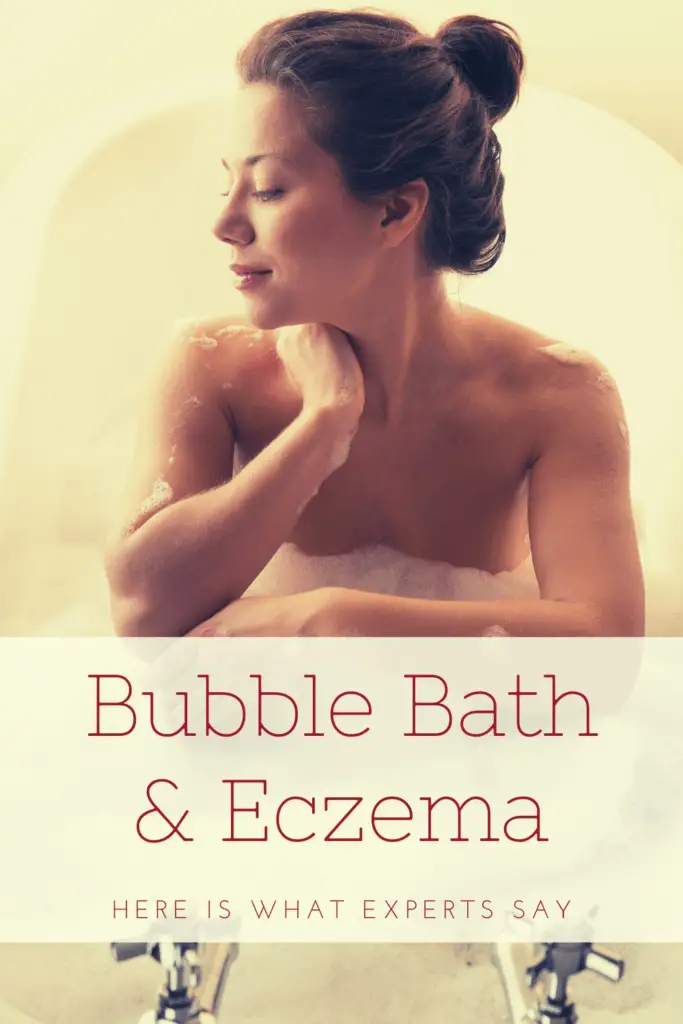Skincare is important, and no one knows that better than people with eczema. When it comes time for bathing, choosing the best cleansing products for dry skin is absolutely essential. So which bubble bath is good for eczema?
Experts agree that bubble baths should be avoided to prevent eczema flare-ups. The main reason is that people suffering from eczema need to limit the use of compounds that dry the skin or are scented, which are generally present in bubble bath formulas. While some more natural options promise better results, they can be a risk for the skincare of people with eczema and won’t provide the same level of bubbliness.
I know. It isn’t what most people want to hear. But don’t get disappointed so quickly! In this article, we’ll go over the ingredients to watch out for when choosing solutions and take a look at alternatives to bubble baths for eczema, so you can still enjoy the relaxation benefits of a great skincare routine.
Table of Contents
Bubble Bath and Eczema: A Close Look At Ingredients
When you experience dermatitis flares, you learn to become comfortable with thoroughly reading the ingredient lists on skincare products. It’s essential for dry skin to limit the usage of drying chemicals or scented solutions. When using skin products, you’ll want to look for dye-free and scent-free options. Also, antibacterial cleansers will usually include alcohol and can be harmful.
Some of the ingredients most commonly found in your average bubble bath solution include fragrance, which may be listed as parfum, benzyl alcohol, parabens, PEGS, phthalates, Methylisothiazolinone/ Methylchloroisothiazolinone, sacilic acid, retinol, and cocamidopropyl betaine.

One of the big ingredients used to make bubbles is sodium lauryl sulfate, often abbreviated to SLS. When they make SLS, they start off with an acid obtained from an oil, often coconut oil. They isolate the fatty acid known as lauric acid. The lauric acid is combined with sulfuric acid for a first reaction and then sodium carbonate to create sodium lauryl sulfate. Unfortunately, SLS is known for disrupting the natural oils in the skin and breaking down the skin’s barrier. This is terrible for people with eczema and should be avoided.
Some people suggest that sodium coco sulfate, which can create bubbles, is an ingredient you could try for bubble baths instead. It is very similar to SLS, except that instead of using just one fatty acid, lauric acid, sodium coco sulfate uses a blend of fatty acids from coconut oil. Because sodium coco sulfate comes from a natural and trusted source, coconut oil, people assume it will have a hydrating effect for everyone. Unfortunately, it is still a synthetic ingredient known to cause reactions in people with eczema, just like SLS.
There are some bubble baths marketed as being “safe” for people with eczema. Some people use them and find that their skin doesn’t seem to react, but they are never a safe bet and you should proceed with care.
Products You Can Add To Your Bath For Relaxation

While bubble bath solutions are a risky option that can worsen dry skin, a good bathing routine can help treat eczema. Let’s take a look at some options that are considered more helpful for skincare.
Salt Baths
Like many options for people with eczema, experts have some disagreements on what’s best here. Keep in mind that any time you try anything with sensitive skin, doing a patch test in a small area can be useful. Watching for your symptoms and being mindful of them is important, since you may have a mild reaction the first time you try something and a severe one the second time around. Be careful with yourself.
When it comes to salt baths, the disagreement comes in on the types of salts and what is most useful.
The National Eczema Society suggests that if you are having a severe flare, adding a single cup of regular table salt to your bath water can ease the symptoms. When you go to take a bath your skin can sometimes flare and a cup of table salt can make this easier for you.

Then, of course, there are Epsom salt baths. Epsom salt is a unique compound of magnesium and sulfate. Some experts believe that Epsom salt is too harsh for people with eczema and represents too much of a risk. There haven’t been enough studies on this to really draw a conclusion. However, some studies have found that magnesium-rich baths improve skin-barrier function and reduce inflammation in dry skin. Considering these discrepancies, you should proceed with care.
If you decide to try an Epsom salt bath for yourself, or a table salt bath, you’ll want to rinse your skin off briefly in the shower before leaving the tub.
Baking Soda

Fortunately, experts are in better agreement over bathing in a baking soda solution. This is meant to help relieve itching. You can mix baking soda with a little water to create a paste you can apply directly to dermatitis and then gently rinse off in the bath. Or, you can add baking soda to a bath and soak for approximately ten minutes.
Oatmeal Baths
An oatmeal bath for eczema is the most popular choice. You want to use colloidal oatmeal meant specifically for bathing. You can mix a touch of colloidal oatmeal with water to create a paste, like with the baking soda, apply it directly to the skin, and then rinse in the bath. This will help relieve itching. It’s also a good way to relax and also works as a great moisturizer.
How do you find oatmeal for your bath? You can purchase oatmeal bath powder at a store. However, it’s worth noting that some people find that there is less guarantee there won’t be chemicals in the solutions sold that could irritate your skin.

A cheaper solution that offers peace of mind is to actually take regular oats and then finely grind them in a food processor or a spice grinder. When you are done soaking in the bath, you may wish to quickly rinse off in the shower so the oatmeal doesn’t cling to your skin.
Bath Oils
This is possibly your fanciest option for a bath with eczema. You need to be extra careful here that your oils don’t contain fragrances. It may be safest to purchase oils themselves without any additives or blends.
Rather than penetrating the skin, oil is less absorbent. It covers the skin and creates a barrier that, for some, can serve as protection. If oils work well with your skin, bathing in them may help you retain more moisture in your skin.

A popular choice among experts is coconut oil. You can add 1/4 cup of coconut oil to your bathwater. Soak for ten to fifteen minutes in lukewarm water. If the coconut oil is hard, add it to some water in a pan in the kitchen first and heat that water up until the coconut oil gets soft. Then, add to your normal lukewarm bathwater.
Always keep in mind that adding oil to your bath will make your tub very slippery. Be careful about this!
Vinegar Baths for Eczema
This is another one that’s controversial among experts, so keep that in mind! The National Eczema Society recommends vinegar baths. Many people with eczema report that soaking in apple cider vinegar has done wonders to help them moisturize.

That being said, studies published in Pediatric Dermatology found that apple cider vinegar baths were not useful and could even irritate dermatitis.
What About Bleach Baths?
You may have heard that bleach baths are a possible treatment for dermatitis. This is another solution where experts heavily disagree. It’s also a more risky suggestion than most since a bleach bath can be harmful to people with asthma or other respiratory issues. It can also cause allergic reactions. Excluding those exceptions, this is a somewhat popular solution for reducing the risks of skin infections.

The National Eczema Society supports bleach baths as a possible solution for some people. They found that adding half a cup of bleach to a tub full of water, soaking for ten minutes, and then rinsing off could be a good way to reduce inflammation. They suggest doing this two or three times a week.
Importantly, they also suggest talking with your doctor before trying this yourself or with a child. With a child, you will want to watch them extra closely while they are in a bleach bath to make sure they don’t submerge their head under the water or drink the solution.
With the amount of bleach they recommend in the water, the chlorine content is similar to that in a swimming pool, so this isn’t quite as intense as it sounds, but it is still something to be careful with.
On the other side of the fence, a study was published in 2017 that found bleach baths were simply not effective. Most of the studies readily available against bleach baths conclude they’re not useful in reducing dermatitis, not that they’re harmful to people who don’t have reactions to the bleach. At this point, more study is needed.
If you or your child are prone to skin infections, bleach baths may help. Always talk to your doctor about this possibility before trying and discuss with him any respiratory issues or allergies you may have.
Is a Bath or a Shower Better for Eczema?

Many assume that soaking in a bath is better for moisturizing. Actually, most of the moisturizing credit you’ll get for bathing comes into play in your routine once you step out of the tub. When it comes to a bath versus a shower for eczema treatment, both have been found to be equally effective.
Of course, many find that a bath is a better experience for relaxation. That said, this is a personal preference. Just make sure that you use lukewarm water and are in the water for ten to fifteen minutes.
Bathing Tips for Eczema
Every person with eczema has to find their own balance for how often to bathe. While everyone should do so daily, some people find their best results are to do this twice daily. You do want to be careful about not showering too often, since that can actually dry your skin out. This is especially true if you don’t follow up every contact with water with moisturizing. Find a routine that works for you and then be consistent with it for the best results.
The goal of your bathing routine is to improve the health of your skin barrier. You want it to be moisturized and flexible to be healthy. Your skin barrier will lock in the moisture you need and keep out the irritants that can cause real health troubles.

The National Eczema Society has clear instructions when it comes to bathing.
- First, always use lukewarm water. Hot showers are tempting but are just not something you can afford if you want to avoid flare-ups. A lukewarm bath or shower is best for the health of your skin, and can certainly still be enjoyable.
- Your bath or shower should last ten to fifteen minutes. Some experts may suggest that a wider range of five to twenty minutes is acceptable. However, the best results are still on average ten to fifteen minutes. It’s also suggested that you may find your individual results vary some with the amount of time you spent in the water. Take note of this and make adjustments for your own health.
- Avoid scrubbing in the shower. Don’t use a washcloth, loofah, shower poof, or anything else. Instead, let the water gently go over your skin. You always want to be as gentle with your skin as possible to avoid irritating it.
- You can use some gentle cleansers. Always test these on your skin in a patch area before putting them on your full body. Avoid soap and, when you’re having a severe flareup, skip the cleansers of any kind.
- As soon as your body is out of the water, you want to be ready to apply a moisturizer within three minutes. This means you will need to keep your moisturizing supplies at the ready.
- Pat your skin lightly with a towel after you get out. You aren’t trying to get dry. You want to leave your skin slightly damp. Pat very gently.
- Do you have a prescription topical medication? This is probably the moment to apply that to any dermatitis. Of course, follow the instructions from your physician.
- Now, moisturize! This should still be done within that three-minute window of time after getting out of the water. It stops your skin from getting the chance to dry out at all. Ideally, you want your moisturizer to be a high-oil content solution that is scent-free, dye-free, and easy on your skin. You want to apply it everywhere, not just in areas currently experiencing a flare-up.
- Wait a few minutes before you get dressed or apply a wet wrap. This gives the moisturizer a chance to absorb.
Bubble Baths and Eczema May Not Mix Well
While experts disagree over many individual products you can add to a bath, they all agree to the answer to one question. When asked, “Which bubble bath is good for eczema?” they loudly tell people not to take bubble baths. While it would be nice if there was a good solution around this, it’s actually one of the top things they tell you not to do. Whenever they mention avoiding soaps, they quickly add, “especially bubble baths!”.
Parents who have children with eczema particularly dislike this advice, but it’s still what the experts have to say on the subject. Bath time is an important place for bonding with children and having fun, but you’ll agree that it’s still most important for your child’s skincare.

Experts are particularly strict when it comes to bathing rules for children with eczema, which can be frustrating, but the rules are meant to help with much bigger, itchier problems. Don’t forget that for children, you can still add fun bath toys to make it lots of fun. A few rubber duckies are probably better than bubbles anyway!
As for adults looking for better relaxation, turn your bathroom into a relaxing haven! Just because bubble baths and eczema don’t mix doesn’t mean your bathroom can’t be a great place for you to relieve stress.

- Consider getting a speaker that is safe to use in your bathroom so you can play soothing music.
- Get candles made for the bathroom. If you’re wishing for the scents of a bubble bath, replace it with a great scented candle.
- Dim the lights to set a full experience.
- Since you need to be gentle with your skin anyway, invest in a nice, soft bath towel. Microfiber towels are often the nicest for people with dry skin.
Yes, it can be easy to focus on the options that seem out of reach, but there are still many great ways you can turn your skincare routine for eczema into a part of your overall relaxation routine for your whole life. Focus on the tools and routines that maximize those benefits for yourself. And have fun!


